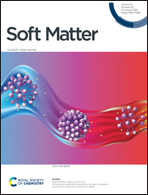Influence of pH on the self-assembly of diphenylalanine peptides: molecular insights from coarse-grained simulations
Abstract
Nanostructures fabricated from peptide self-assemblies are attracting increasing attention owing to their possible applications in biology and nanotechnology. A known example is an aromatic dipeptide (diphenylalanine, FF) which is extracted from Alzheimer's β-amyloid polypeptide as the core recognition motif for molecular self-assembly. Many studies have been carried out to organize FF peptides into various functional ordered nanostructures. For potential applications of self-assembled FF-based nanomaterials, it becomes important to consider some influencing factors (e.g., solvents, peptide concentrations, pH, temperature, etc.) on the self-assembly process. Among these factors, the effect of pH on the self-assembly process of FF peptides into assembled nanostructures through simulation studies is the main focus of the present work. In the current study, we have investigated the assembly pathway of 1000 FF peptides and qualitatively evaluated the morphological changes of FF-based nanostructures at different pH values by performing extensive coarse-grained molecular dynamics (CG-MD) simulations. Structural analyses suggest that FF peptides can spontaneously assemble into nanotubes with different shapes under acidic, neutral and basic conditions. Based on the analysis of FF nanostructure formation pathways in different pH solutions, the self-assembly of the nanotube involves the aggregation of molecules to form a bilayer, the curling of a bilayer to form a vesicle and the transformation of a vesicle into a tubular structure. It is noted that a flat hollow columnar structure is observed as a special intermediate state during the transformation process of a vesicle-like to a tube-like structure. Energetic analysis suggests that the aggregation of FF peptides is driven by the vdW interactions but the aggregation shape is mainly affected by the electrostatic interactions. Overall, this study provides further understanding of the self-assembly behavior of aromatic short peptide derivatives in different pH solutions.



 Please wait while we load your content...
Please wait while we load your content...